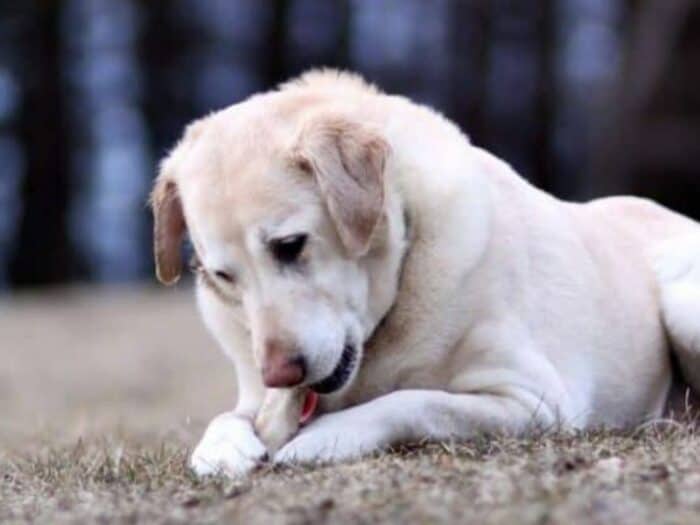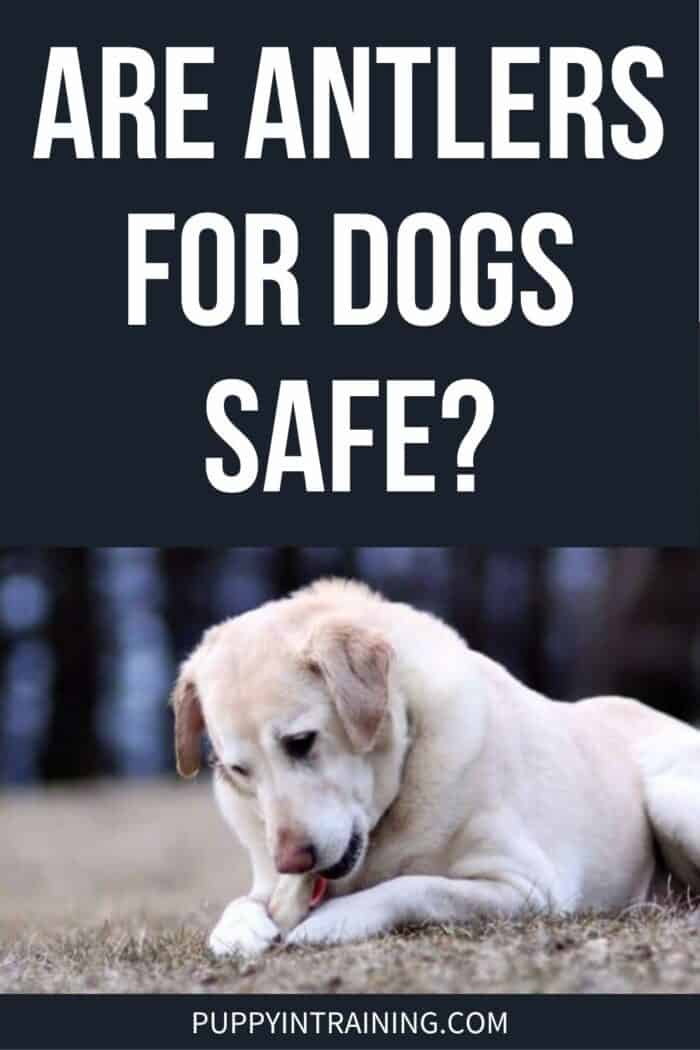Are Antlers for Dogs Safe? – A Professional Dog Trainer’s Opinion
This post may contain affiliate links. We may earn money or products from the companies mentioned in this post.
Like you, I’m always looking for a great, safe type of chew for my dogs. When choosing, I do some internet research and ask the advice of my dog-loving friends and vet.
Antlers have become a very popular item and I was wondering: Are antlers for dogs safe?
Many pet parents give them to their dogs to help clean their teeth and keep them occupied.
There haven’t been any clinical studies about whether antlers should be given to dogs, so it’s up to us to make the decision.
Many of my clients have given them to their dogs with success.
I’ve been a certified pet dog trainer for many years. So I investigated whether I wanted to give them to my dogs or recommend the antlers to others.
In deciding, I weighed the risks versus the benefits.
I have five dogs at the present time. Some are more aggressive chewers than others.
Are Antlers For Dogs Safe?
In this article, I’ll tell you about what I’ve discovered about antlers for dogs and my conclusion.

Antlers For Dogs: The Basics
There are three types of antlers on the market that are popular: deer antlers, elk antlers, and moose antlers.
They’re naturally shed each year, and the animal regrows another set. So no animals are harmed in the making of antlers.
Check out this video of a moose losing both his antlers at the same time:
Kind of startled him. Can you imagine if that tremendous amount of weight was suddenly lifted from your head? You’d be startled too 🙂
The outer layer is a very hard bone and the inner portion is a little softer marrow.
Some wild animals in the wild even enjoy them.
They can help clean a dog’s teeth and prevent boredom. And the inner marrow has some nutrients that are beneficial.
The Hard Truth
Each type of antler varies slightly in how hard it is.
Reindeer antlers are often harder than other types.
Elk antlers are generally softer than deer antlers, but still have a very hard bony exterior. And moose antlers are said to be slightly softer than other antler types.
You can also buy antlers that have been slit in half lengthwise, exposing the marrow inside.
It’s easier for a dog to eat the marrow part in the split antlers but they still are chewing the harder bony exterior too.
Although they may vary slightly in hardness in their bony exteriors, they are all very hard on a dog’s teeth.
They also vary in shapes and sizes, as they are natural items. They’re cut up into various sized pieces.
So, if you decide to use them, you need to get a size that’s appropriate for your dog to chew. The antler should be large enough that your dog can’t ingest it or choke on it.
Benefits of Antlers
There are some benefits that recommend the use of antlers. Of course these have to be weighed against the downside.
Antlers have the following benefits:
- Happy dog! Most dogs love chewing on antlers. They love the taste and chewing keeps them from getting bored.
- Clean teeth! Chewing antlers can help remove tartar on a dog’s teeth.
- Nutrition! The antlers provide minerals, including calcium, potassium, iron, zinc, and phosphorus.
- Low-fat! Unlike some dog chews, such as pigs’ ears, antlers are a low-fat treat.
- Long-lasting! Antlers generally last a long time for most dogs if the appropriate size is given to them.
- No allergies! As a single source of protein, most dogs with allergies can chew antlers.
- Sustainable and humane! Because they are naturally shed, no animals are harmed in the process. And they shouldn’t have any artificial ingredients or other harmful chemicals.
- Odor-free! Unlike some dog chews like bully sticks, antlers don’t smell.
Downside of Antlers
On first look, antlers appear to be the answer to a dog lover’s prayers. They last long, most dogs love them, and they can lead to dental health.
But there are many reasons that antlers aren’t as great as they at first appear, including the following reasons:
- Dental risk! Because all antlers have a very hard bony exterior, they may lead to chipped or cracked teeth, abscesses, and infections. Even if a tooth isn’t damaged, chewing may cause your dog’s gums to bleed, leading to potential infection. This can lead to a lot of pain for your beloved canine. And a lot of expense to you if a tooth needs to be removed under general anesthesia.
- Internal damage! Chunks or pieces of an antler may break off when your dog’s chewing it. Unfortunately, this can lead to internal damages or blockages. Some owners even see pieces in their dog’s feces. If pieces break off, emergency surgery may be necessary.
- Choking hazard! As is true with any chew or toy, antlers can pose a choking hazard. This is especially true if too small an antler is chosen or a piece breaks off.
- Intestinal Issues! Antlers can also potentially cause diarrhea and other intestinal problems.
Should You Give Your Dog Antlers?
As a dog owner, I realize that it’s a difficult decision.
I’ve decided that I won’t give antlers to my dogs or recommend them to others.
Even though there are many positive reasons to recommend them, I feel that the risks outweigh the benefits.
Many vets have come to the same conclusion, including Dr. Marty Becker, a well-recognized veterinarian.
He believes that dogs shouldn’t be given anything that’s extremely hard–especially to aggressive chewers.
He cites hard plastic or nylon chews, sterilized bones, cow hooves, and antlers as all being too hard for dogs to safely chew.
And many experts indicate that, even if someone decides to give their dog antlers, they shouldn’t be given to puppies, seniors, or dogs with tooth decay or gum disease.
And if you choose to give your dog antlers, it’s important to give a high-quality antler that hasn’t been processed with harmful chemicals.
Many are being imported from other countries and they may have been processed with harmful chemicals.
Of course, if you have a dog with dental issues, he should be checked out by your vet to determine whether any teeth should be pulled or other action taken.
In fact, it’s important to have your dog check your dog’s teeth at least yearly. And twice a year for senior dogs.
Over 80 percent of dogs over the age of three show signs of dental disease. So what’s safe anymore to chew?
Alternatives to Antlers
Of course dogs need a safe chew. But anything we give our dogs to chew–including antlers–should be given with supervision.
In fact, the Veterinary Oral Health Council (VOHC) has developed a list of approved chews for dogs.
Most of the chews on this list are man-made for dental health.
What you ultimately choose should depend on your dog’s age, health (including dental health), and how aggressive a chewer he is.
Many people successfully use sterilized bones that don’t splinter or nylon bones. But, if you have a very aggressive chewer, even they can potentially lead to dental woes as they are very hard.
Many experts don’t approve of the use of rawhide, as it may be processed with harmful chemicals. Or it may cause a blockage or choking hazard if a piece is chewed off.
I’ve used beef collagen sticks with success. They soften from the dog’s saliva as he chews.
Also, bully sticks are a great option, although a stinky option (I think that’s why the dog’s love them so much).
Of course, you want one that’s appropriately sized for your dog. They come in various lengths and thicknesses.
They should be thick and long enough that chunks cannot come off.
They’re meant to be worn away so that they don’t cause problems like blockages.
And they should be taken away when they get too small that they can be entirely put in a dog’s mouth. They even make holders for them so a dog can’t chew them to the end.
Make sure that the bully sticks you use aren’t processed with chemicals. A downside of bully sticks is that high-quality ones (which is all you should use) are pretty expensive.
Yak Cheese Dog Chews have become popular too. Of course, they have to be the correct size and used with supervision too. And they can be expensive.
You should always supervise your dog chewing and remove any item that’s become unsafe.
Final Thoughts
As is true with anything we give to our beloved dogs, we have to weigh the benefits against the risks.
I’ve decided that the potential risks of antlers outweigh any benefits for my dogs.
The decision’s up to you for yours.
Have you given your dog antlers to chew?
What do you think? Are antlers for dogs safe?
Please tell us about it in the comment section below.
Related Article:
Save To Pinterest

Top Picks For Our Puppies
- BEST DOG CHEW
We Like: Beef Collagen Sticks - All of our pups love to bite, nip, and chew. We love using Collagen Sticks to help divert these unwanted behaviors. - BEST PUPPY TOY
We Like: Calmeroos Puppy Toy w/ Heartbeat and Heat Packs - Perfect for new puppies. Helps ease anxiety in their new home. - BEST DOG TREATS
We Like: Crazy Dog Train-Me Treats - We use these as our high-value treats for our guide dog puppies. - BEST FRESH DOG FOOD
We Like: The Farmer's Dog - A couple months ago we started feeding Raven fresh dog food and she loves it! Get 50% off your first order of The Farmer's Dog.
Check out more of our favorites on our New Puppy Checklist.